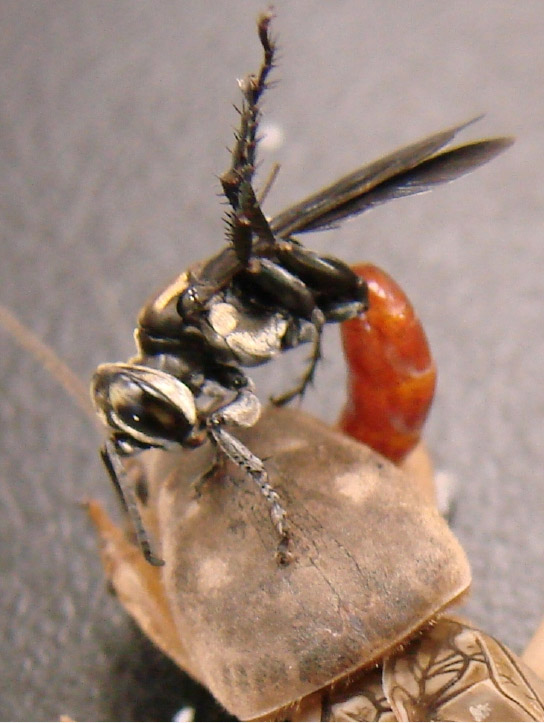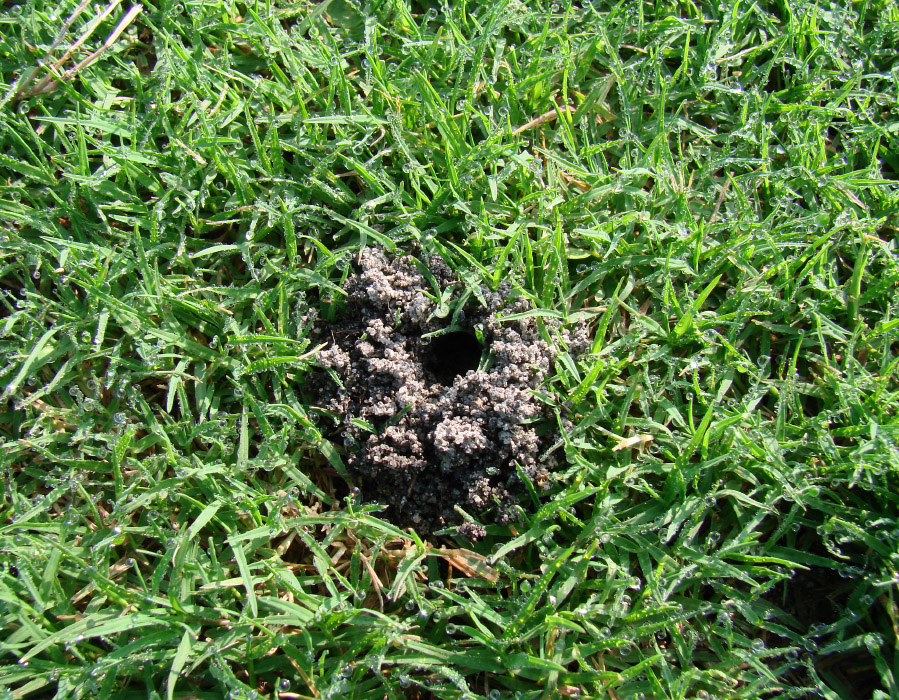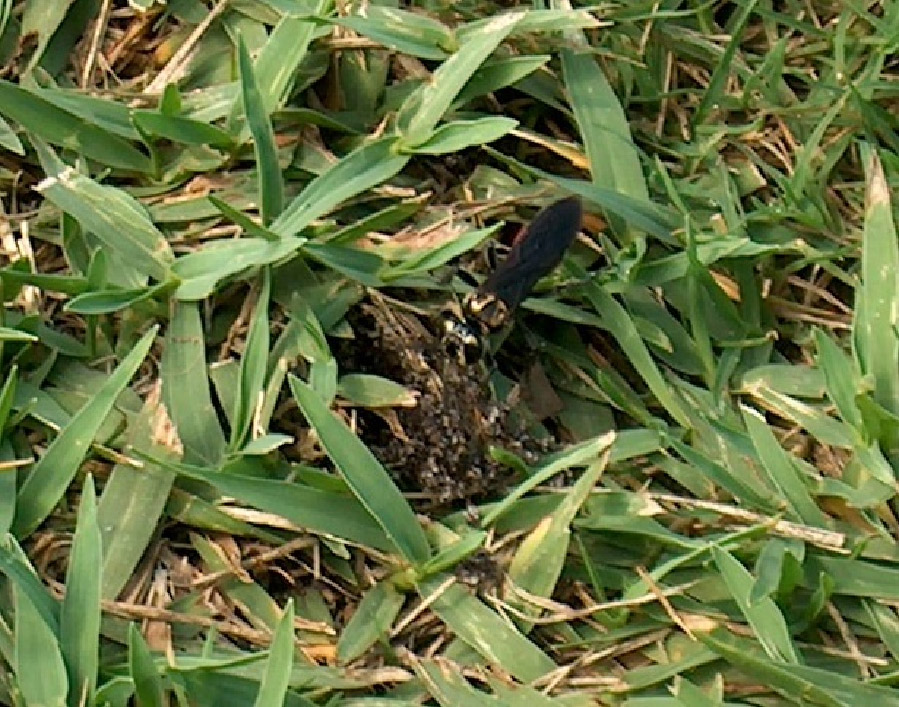Research Article
First Report of Larra bicolor (Hymenoptera: Sphecidae) in Alabama [pdf]
Abraham, C. M., D. W. Held*, and C. Wheeler
Mississippi State University, Coastal Research and Extension Center, 1815 Popps Ferry Rd. Biloxi, MS 39532 david.held@msstate.edu
*To whom correspondence should be addressed. Current address: Department of Entomology and Plant Pathology, 301 Funchess Hall, Auburn University, Auburn, AL 36849 phone: (334 )844-5006
Received: 4-IV-2008 Accepted: 27-V-2008
Abstract: A survey of golf courses in southern and coastal Alabama has revealed a new record of Larra bicolor in Alabama. Larra bicolor males and females were collected or observed on four of the eight golf courses sampled.
Keywords: digger wasp, biological control, mole crickets, Scapteriscus
Introduction
Mole crickets (Orthoptera: Gryllotalpidae: Scapteriscus spp.) are serious pests of warm season turfgrass and pastures in the southern United States. Since their entry into United States along the Georgia coastline in the early 1900’s, Scapteriscus mole crickets have spread south into Florida and west through Louisiana. In Mississippi and the northern Gulf region, two species, S. vicinus and S. borellei, are present whereas these two and S. abbreviatus are present in Florida. Damage from Scapteriscus mole crickets is most severe in the southernmost areas of Gulf states (Frank and Walker 2006). On golf courses, insecticides are used extensively to prevent damage from mole crickets. For example, control may cost up to $270 per acre. Combined effects of three natural enemies, Ormia depleta (Diptera: Tachinidae), Steinernema scapterisci (entomopathogenic nematode), and Larra bicolor F. (Hymenoptera: Sphecidae) are attributed with a 99% reduction in mole cricket populations in Florida (Frank and Walker 2006).
Larra bicolor (Fig. 1) is an ectoparasitoid of mole crickets and has 2 to 3 generations per season (Frank and Sourakov 2002) . The biology and ecology of L. bicolor were recently reviewed (Frank et al. 1995, Frank and Sourakov 2002) and will not be discussed in detail. Larra bicolor wasps are black with wings that are brown to blue and a solid red abdomen (Fig. 1) which distinguishes it from Larra analis F. which is native to Mississippi and other Gulf states, and has a black abdomen with red just at the tip (Menke 1992). Between 1981–1983, researchers collected L. bicolor wasps from Puerto Rico and released them into the five sites in Florida. Following these releases, wasps only became established at the southernmost release site near Ft. Lauderdale (Frank et al. 1995). In an attempt to establish populations in northern Florida, three species of wasps, Larra bicolor, L. praedatrix, and L. godmani were collected from Bolivia and released along with parasitized hosts at three sites near Gainesville in 1988-89 (Frank et al. 1995). Again, these releases appeared unsuccessful until 1993 when L. bicolor were observed attacking mole crickets and feeding on flowers of Spermacoce verticillata in Gainesville.
Figure 1. Larra bicolor (15–20 mm long)is shown here feeding on flowers of Spermacoce verticillata (left) and stinging a mole cricket (right). The solid red abdomen of L. bicolor distinguishes it from L. analis a native species.
In 2004,several specimens of L. bicolor were collected from golf courses in coastal Mississippi. Larra bicolor currently is widespread in Florida (Frank et al. 1995, Frank and Walker 2006) and reported from southern counties in Mississippi and Georgia (Held 2005). The most northern collection of L. bicolor in Mississippi is (30.69 °N) Saucier, MS (D.W. Held, unpublished data) and most established populations of L. bicolor in the U.S. occur at ≤ 31°N latitude (Frank and Walker 2006). Larra bicolor was intentionally released in southern Georgia in 2000 by W. Hudson for biological control of mole crickets (W. Hudson, personal communication). With no records of release in Mississippi, the discovery of L. bicolor suggests natural range expansion of this wasp along with its host (Held 2005). Range expansion from Florida to Mississippi would indicate that L. bicolor may also be present in Alabama. Because mole crickets are more problematic in southern counties of Mississippi and Alabama, we sampled golf courses in the Mobile and Baldwin counties of Alabama to determine if and where Larra bicolor was present. If found, turfgrass managers in south Alabama could benefit by knowing L. bicolor is present and therefore utilize information from on-going research.
Materials and Methods
For this survey, southern Alabama (< 31°N latitude) was divided into three regions; the metro Mobile area, the eastern shore of Mobile Bay, and coastal Alabama including Gulf Shores. Between 26 Sept and 19 Oct. 2007, golf courses in each region were selected and sampled for L. bicolor. On each course, the greens staff or superintendents suggested at least three fairways infested with mole crickets to sample. Surveys were conducted between 0800–1400 hours. All observers walked, side by side, in a line spanning the width of the fairway. Every observer walked each fairway from tee to green. Particular attention was given to areas with fresh mole cricket damage. If L. bicolor wasps were observed attempts were made to collect them. When captured, wasps were collected with nets then transferred to collection bottles in a cooler for transport to the laboratory. If unsuccessful, the wasp was noted as observed but not collected and the survey resumed to the end of the fairway.
Results and Discussion
Larra bicolor wasps were found on at least one golf course in each of the three geographical regions in south Alabama (Table 1). This record is the first report of this beneficial wasp in Alabama. It is probable that the populations of L. bicolor established in south Alabama have resulted from natural range expansion of this wasp within it’s host’s range (Held 2005).
Adult L. bicolor was rarely found in all areas surveyed on a particular golf course. Wasps were more common in areas or on golf courses where fresh mole cricket damage was more apparent. Some golf courses were more aggressive with their mole cricket management programs and those courses had fewer or smaller areas that were damaged. Because L. bicolor wasps are difficult to sample, non-detection of wasps on certain sites during this survey should not be equated with an absence of wasps on that course or geographical area. In a survey of golf courses in coastal Mississippi in 2004, Held (2005) reported certain sites where L. bicolor were present or absent. Since that survey, L. bicolor has been collected from one site where it was undetected in 2004, and populations are now absent from one site where they were once present (Held and Abraham, unpublished data). Temporal or seasonal abundance in wasp populations is likely determined by host abundance, presence of nectar sources (Leppla et al. 2007), or surface-applied insecticides.
Table 1. Numbers of Larra bicolor reported from golf courses in south Alabama.

On three of the four sites where L. bicolor wasps were found, mole cricket mounds with holes in the top of them were also observed (Fig. 2). Larra bicolor females move along the grass surface searching for mounds. Once a mound is detected, the soil is antennated and the wasp may choose to enter. To enter a mound, the female must burrow through the soil at the surface. It then proceeds into the subterranean tunnels in search of a host. As a result, mole crickets commonly exit the mound to avoid attack. Holes similar to these are commonly observed on several sites in south Mississippi where L. bicolor are present. These holes, therefore, may result from either the wasp entering or the mole cricket escaping the mound and may be a passive indication that L. bicolor is active in that area.
The discovery of L. bicolor in southern and coastal Alabama provides a new record for this species but more importantly it provides new information for turfgrass managers. On-going research projects in Florida (H. Frank, personal communication) and Mississippi are investigating the role of flowering plants in parasitism and survival of L. bicolor. Turfgrass managers and homeowners in Alabama can now utilize the findings of this and future research on biological control of mole crickets.
Figure 2. A female L. bicolor preparing to enter the mound in search for a mole cricket (left). Mole cricket mound with hole that was commonly observed on sites where L. bicolor wasps were active (right).
Acknowledgements
We thank the superintendents, staff, and membership of the eight golf courses in southern Alabama for their cooperation. Blake Layton, Gary Bachman, and Dave Burrage (MS State Univ.) provided helpful comments on an earlier draft of this manuscript. We also thank the Gulf Coast Superintendents Association Research Fund for funding this work. Vouchers of Larra bicolor collected during this survey have been deposited into the Entomology Collection at Auburn University. This paper is no. J–11313 of the Mississippi Agricultural and Forestry Experiment Station.
References
Frank, J. H., and A. Sourakov. 2002. Larra wasps, Larra analis Fabricius; Mole Cricket Hunters (Hymenoptera: Sphecidae). FL. Coop. Ext. Ser. Pub. EENY–268.
Frank, J. H., and T. J. Walker. 2006. Permanent control of pest mole crickets (Orthoptera: Gryllotalpidae:Scapteriscus) in Florida. Amer. Entomol. 52: 138–143.
Frank, J. H., J. P. Parkman, and F. D. Bennett. 1995. Larra bicolor (Hymenoptera: Sphecidae), a biological control agent of Scapteriscus mole crickets (Orthoptera: Gryllotalpidae), established in northern Florida. Florida Entomol. 78: 619–623.
Held, D. W. 2005. Occurence of Larra bicolor (Hymenoptera: Sphecidae), ectoparasite of mole crickets (Scapteriscus spp.), in coastal Mississippi. Florida Entomol. 88: 327–328.
Leppla, N. C., J. H. Frank, M. B. Adjei, and N. E. Vincente. 2007. Management of pest mole crickets in Florida and Puerto Rico with a nematode and parasitic wasp. Florida Entomol. 90: 229–233.
Menke, A. S. 1992. Mole cricket hunters of the genus Larra in the New World (Hymenoptera: Sphecidae, Larrinae). J. Hymenoptera Res. 1: 175–234.




